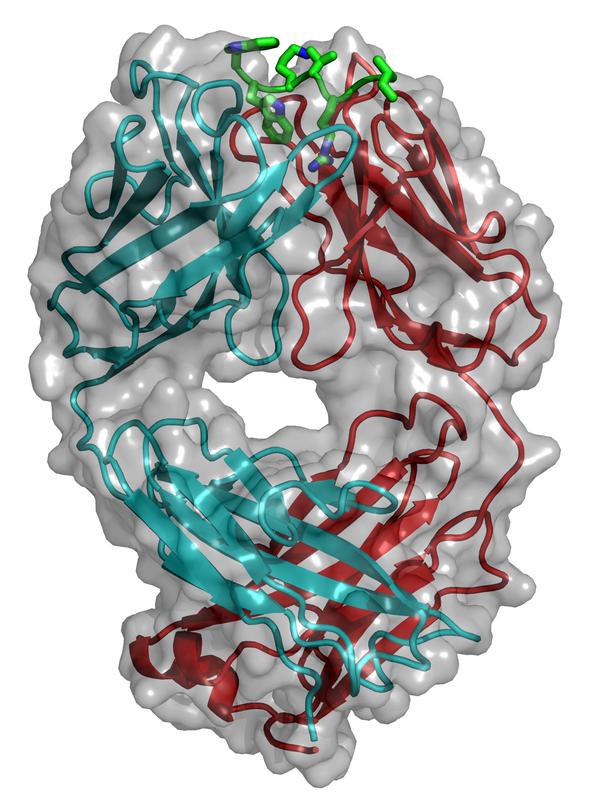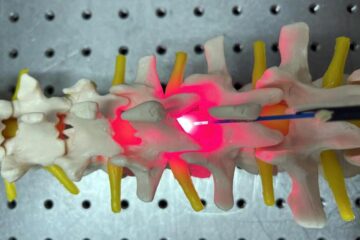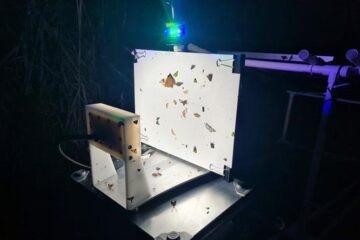Osteoporosis: Antibody crystallised

Model of a Sclerostin-fragment (green) bound to the antibody AbD09097 (heavy and light chain in cyan and red, respectively; surface representation in grey) (Figure: Thomas Müller)
Osteoporosis particularly affects elderly women: the bone’s structure weakens and the risk of suffering fractures rises. As prophylaxis patients are advised to have a healthy diet and perform physical exercises; when the risk of bone fractures is high, medicine preventing further bone loss is prescribed in addition.
In the search for better treatments for this disease the protein Sclerostin, which plays an important role in bone metabolism, is of major interest. When its function is impeded, bone resorption diminishes and bone re-growth is stimulated.
First clinical trials with a Sclerostin-inhibiting antibody developed by the companies Amgen and UCB showed promising results in that the bone mass of participants suffering from osteoporosis increased. Currently, studies are continued at several locations, amongst others Würzburg, Munich and Dresden.
Verena Boschert, Postdoc in the team of structural biologist Prof. Thomas Müller at the Julius-von-Sachs Institute (Julius-Maximilians-Universität Würzburg, JMU, in Bavaria, Germany) is also working on the protein Sclerostin. In a collaborative project with several project partners and funded by the European Union and the Deutsche Forschungsgemeinschaft novel Sclerostin-inhibiting antibodies were generated and analysed for their suitability as osteoporosis treatment option.
Now, for the first time the JMU scientists crystallized an antibody effective against Sclerostin and analysed its mode of action in detail. Recently, these results were published in the journal Open Biology. “Our findings could have a positive impact on the design of new inhibitory antibodies targeting Sclerostin”, says Boschert.
Cooperation with two companies
In this project the scientists from Würzburg are working together with partners from industry. In cooperation with AbD-Serotec, having its German subsidiary in Puchheim, ten promising antibodies were developed in the initial round. After testing in cell culture one (AbD09097) showed the favoured activity to neutralize Sclerostin.
Together with the company Pepscan (Lelystad/ The Netherlands) and the Leibniz Institute for Pharmacology in Berlin an in-depth analysis of the binding epitopes was performed using peptide chemistry and NMR spectroscopy. From these methods the binding site of the antibody in Sclerostin could be deduced.
Further steps in the project
”Until now, we could only determine the structure of the antibody alone “, Boschert points out. As the next step it is planned to crystallize the antibody together with Sclerostin or a binding fragment. Thereby, a more detailed view of the interaction between antibody and its target will be obtained.
The sclerostin-neutralizing antibody AbD09097 recognizes an epitope adjacent to sclerostin's binding site for the Wnt co-receptor LRP6. V. Boschert, C. Frisch, J. W. Back, K. van Pee, S. E. Weidauer, E.-M. Muth, P. Schmieder, M. Beerbaum, A. Knappik, P. Timmerman, T. D. Mueller. Open Biology 2016 6 160120; DOI: 10.1098/rsob.160120. Published 24 August 2016
Contact
Prof. Dr. Thomas Müller, Biocenter, Julius-von-Sachs Institute, JMU, T +49 31 31-89207, mueller@biozentrum.uni-wuerzburg.de
Dr. Verena Boschert, Biocenter, Julius-von-Sachs Institute, JMU, T +49 931 31-80910, verena.boschert@uni-wuerzburg.de
http://rsob.royalsocietypublishing.org/content/6/8/160120 Link to Open-Access article
Media Contact
All latest news from the category: Life Sciences and Chemistry
Articles and reports from the Life Sciences and chemistry area deal with applied and basic research into modern biology, chemistry and human medicine.
Valuable information can be found on a range of life sciences fields including bacteriology, biochemistry, bionics, bioinformatics, biophysics, biotechnology, genetics, geobotany, human biology, marine biology, microbiology, molecular biology, cellular biology, zoology, bioinorganic chemistry, microchemistry and environmental chemistry.
Newest articles

Red light therapy for repairing spinal cord injury passes milestone
Patients with spinal cord injury (SCI) could benefit from a future treatment to repair nerve connections using red and near-infrared light. The method, invented by scientists at the University of…

Insect research is revolutionized by technology
New technologies can revolutionise insect research and environmental monitoring. By using DNA, images, sounds and flight patterns analysed by AI, it’s possible to gain new insights into the world of…

X-ray satellite XMM-newton sees ‘space clover’ in a new light
Astronomers have discovered enormous circular radio features of unknown origin around some galaxies. Now, new observations of one dubbed the Cloverleaf suggest it was created by clashing groups of galaxies….





















